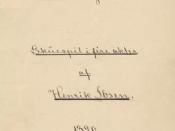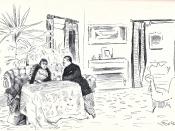Hedda Gabler is not an easy character to get to know. At first reading she seems a bitter personality portrayed in an old-fashioned script set in an out-outmoded and foreign society. How could a woman in 102-year-old play possibly be understandable or relevant to the late-twentieth-century student? However, upon further examination,Hedda Gabler's fictional reality not only offers us the opportunity to observe the art and social concerns of Ibsen's day, but extends to us a paradigm by which we may compare and evaluate the principles of our day.
In approaching this play, it is important to recall that Hedda was written as a theatrical work in the realm of contemporary realism, not as a historical curio. While the differences of culture and period now put a certain distance between ourselves and the subject, Ibsen was most emphatic that his characters were representative of actual human beings. Although in his two previous works, Rosmersholm and The Lady From the Sea, Ibsen had begun exploring the human psyche in more symbolic, mystical terms,Hedda marked a return to the theatrical style which we term "realism," a method of playwriting in which the internal motivations of the personalities in the play are explored within a specific social context.
Other hallmarks of the realistic style include the avoidance of devices such as soliloquies in favor of more natural exposition, causally related scenes leading logically to a denouement, and the creation of individual behavior directly attibutable to the heredity or environment of the character. All external stage details were authentic to the specific and current environment; all costumes, dialogue, and settings were carefully chosen to reveal the characters' more critical psychological impulses. Though his dialogue may appear to modern readers as somewhat awkward and even coy, part of Ibsen's genius was the ability...


![Young Mother Carrying A Child On Her Back In The Market, Hong Kong Island [c1946] Hedda Morrison [RESTORED]](https://s.writework.com/uploads/11/110179/young-mother-carrying-child-her-back-market-hong-kong-island-thumb.jpg)